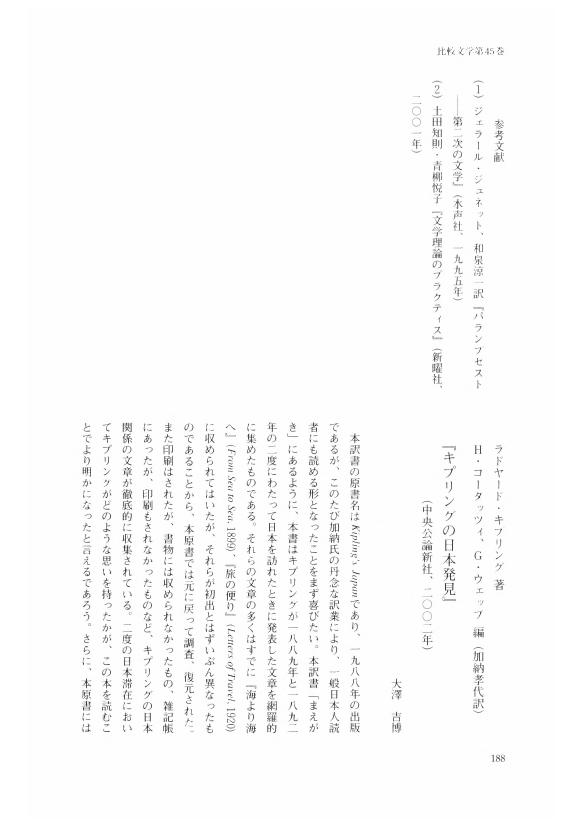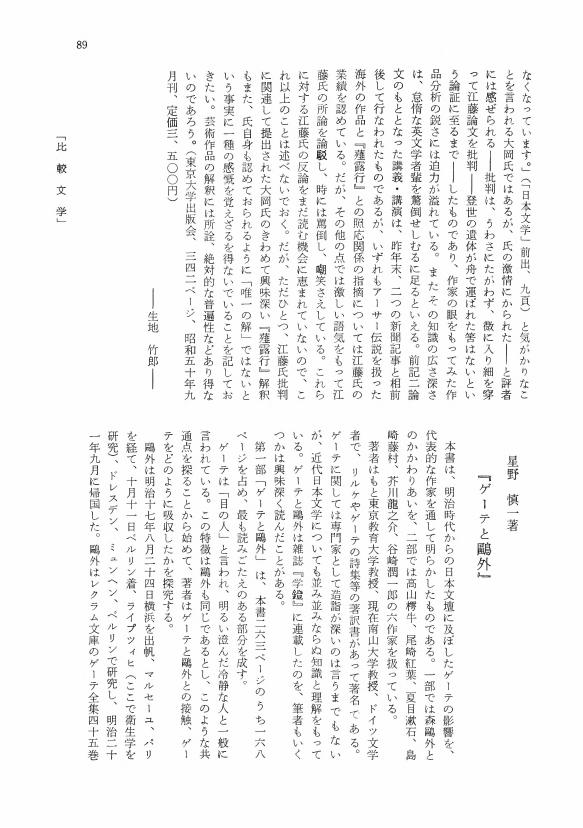1 0 0 0 日本におけるホーソンの滲透
- 著者
- 佐藤 孝己
- 出版者
- 日本比較文学会
- 雑誌
- 比較文学 (ISSN:04408039)
- 巻号頁・発行日
- vol.6, pp.30-39, 1963
<p> For some twenty years since the Restoration of Japan (the Meiji Ishin),Japanese showed crazy enthusiasm toward English. Even after that it has been taught at most schools as the first foreign language. Surveying the literature and translations of Hawthorne in Japan, I found that the English Instruction since the Meiji Ishin played the part of medium to introduce Hawthorne.</p><p> In the Meiji Era American textbooks were used at schools. Among them were Wilson, Sanders' Union, Longman, New National and Swinton, Readers. Some of them gave several pieces of Hawthorne's Stories, which were necessarily taken from his juvenile books. They were "Benjamin West" taken from <i>Biographical Stories for Children</i> (<i>New National Readers</i> V), "The Pine-Tree Shillings" from <i>The Whole History of Grandfather's Chair</i> (<i>Sanders' Union Readers</i> IV),"Ben Franklin's Wharf" from <i>Biographical Stories for Children</i> (<i>Swinton's Fourth Reader</i>) and "Oliver Cromwell", from <i>Biographical Stories for Children</i>, "Worth Her Weight in Silver" from <i>The Whole History of Grandfather's Chair</i>. (<i>Swinton's Fifth Reader</i>).</p><p> The condition urged the publication of other stories of Hawthorne in his juvenile books as supplementary readings. Hawthorne's juvenile books have their own merits. Each of the stories seems to be told in a casual way but it implicates something important to life. Therefore, teachers and pupils were apt to read the moral part of Hawthorne's works, even in reading <i>Twice-Told Tales</i>.</p><p> Now I will show the list of his short stories in the order of frequency in translation.</p><p> 1 "David Swan"</p><p> 2 "The Ambitious Guest"</p><p> 2 "The Great Stone Face"</p><p> 4 "Doctor Heidegger's Experiment"</p><p> 4 "The Vision of the Fountain"</p><p> 6 "A Rill from the Town Pump"</p><p> 6 "The Minister's Black Veil"</p><p> 8 "Fancy's Show Box"</p><p> In surveying Hawthorne in Japan we should never forget Peter Parley's <i>Universal History</i>. Nowadays it is widely recognized that Hawthorne wrote the book with the help of his sister Elizabeth. The book was one of the historical books that commanded a wide audience for the first half of the Meiji Era. In this case we notice again that the book was introduced to many boys and girls through the medium of schools.</p>
1 0 0 0 OA 井村君江著 『「サロメ」の変容―翻訳・舞台』
- 著者
- 堀江 珠喜
- 出版者
- 日本比較文学会
- 雑誌
- 比較文学 (ISSN:04408039)
- 巻号頁・発行日
- vol.34, pp.204-207, 1992-03-31 (Released:2017-07-31)
1 0 0 0 ベルギー象徴派における文学と美術の照応
- 著者
- 三田 順
- 出版者
- 日本比較文学会
- 雑誌
- 比較文学 (ISSN:04408039)
- 巻号頁・発行日
- vol.51, pp.21-35, 2009
<p> Cette étude traite de l'écrivain Georges Rodenbach (1855-1898) et du peintre Xavier Mellery (1845-1921), et prend en considération les correspondances entre les oeuvres de ces deux symbolistes belges. Bien qu'un rapport direct n'ait jamais été décelé entre ceux-ci, les oeuvres de Mellery montrent une analogie étonnante, comme si elles étaient la paraphrase picturale de la « ville morte grise » que Rodenbach avait si souvent décrite.</p><p> On mettra d'abord en lumière le « mythe nordique » représenté dans les oeuvres littéraires de Rodenbach. Celui-ci est notamment évoqué par l'image de Bruges en tant que la ville morte du Nord; image fort appréciée auprès de ses lecteurs principaux, les parisiens, pour son « exotisme du Nord ».</p><p> Ainsi, on comparera Mellery et Rodenbach en se concentrant sur les similarités de ces deux évocations de l'image nordique. Quand Rodenbach veut souligner la particularité de la culture flamande, il mentionne et loue souvent l'art des primitifs flamands. Toutefois, le monde grisaille et désert de Rodenbach est plus précisément représenté dans <i>L'Âme des choses,</i> la série de dessins clairs-obscurs de Xavier Mellery.</p><p> En outre, <i>L'Âme des choses,</i> qui dépeint des sujets quotidiens de façon réaliste dans le cadre du symbolisme, hérite de la tradition réaliste de la « peinture du Nord » et on peut trouver de nombreux peintres symbolistes montrant pareille inclination artistique dans l'école belge. Rodenbach et Mellery créèrent ainsi une expression analogue au travers de deux disciplines distinctes en se rattachant tous deux au « Nord »; cette tendance commune pent en effet être considérée en tant que l'« esprit du temps » dans le symbolisme belge.</p>
- 著者
- 大澤 吉博
- 出版者
- 日本比較文学会
- 雑誌
- 比較文学 (ISSN:04408039)
- 巻号頁・発行日
- vol.45, pp.188-189, 2003-03-31 (Released:2017-06-17)
1 0 0 0 OA 星野 慎一著 『ゲーテと鷗外』
- 著者
- 福田 英男
- 出版者
- 日本比較文学会
- 雑誌
- 比較文学 (ISSN:04408039)
- 巻号頁・発行日
- vol.19, pp.89-90, 1976-12-20 (Released:2017-07-31)
1 0 0 0 小林愛雄の歌劇翻訳
- 著者
- 伊藤 由紀
- 出版者
- 日本比較文学会
- 雑誌
- 比較文学 (ISSN:04408039)
- 巻号頁・発行日
- vol.51, pp.106-120, 2009
<p> In the 1910s in Japan, attempts were made to perform European operas by translating their lyrics into Japanese. One of the leaders of the movement, Kobayashi Aiyû (1881–1945) translated 15 librettos for grand and comic operas during the decade. Although some of the pieces from those works were widely sung in prewar Japan, there have been few studies about Kobayashi's translation.</p><p> In this paper, we will discuss the libretto of Franz von Suppé's comic opera <i>Boccaccio,</i> translated by Kobayashi in 1915 at its Japan premier, to understand how Kobayashi rendered lyrics with meters and rhymes into non-accentual Japanese language.</p><p> Although a song from the work, <i>"Beatori nêchan"</i> ("Holde Schöne, hör diese Töne"), is still known today, we find that the lyrics of the piece in Kobayashi's libretto are more dignified than today's colloquial version.</p><p> Prosodic analysis suggests that Kobayashi used the English translation of the libretto (1880, by Dexter Smith) as a direct source, rather than its original text written in German (1879). Therefore, Kobayashi's lyrics have the same alteration of versification from the German libretto as the English version. Moreover, Kobayashi sometimes seems to have ignored the syllable number required by Suppé's score. Accordingly, his lyrics presented some difficulty in singing so that singers might have to alter the wordings.</p><p> Despite all these problems, Kobayashi was good at songs about love or nostalgia. Therefore, <i>"Koi wa yasashii nobe no hanayo"</i> ("Hab' ich nur deine Liebe") from the same work has been sung in his original lyrics until today.</p>
1 0 0 0 シンデレラ・ストーリーのルーツ論
<p> Die Märchen von Charles Perrault mit den moralischen Lehren wurden 1915 mit dem Titel „Kristallschuh" ins Japanische übersetzt. Die erste Abhandlung vom europäischen Aschenputtel und dem japanischen wurde 1938 von Kunio Yanagida verfaßt. Das europäische Aschenputtel und das japanische Madchen mit dem Holznapf haben mich seit über zehn Jahren fasziniert. Nun erkannte ich, daß seine Hypothese über die Heimat des europäischen Aschenputtels keine logische Schluß folgerung hat. Dr. Doi schreibt, daß Frau R.M. Cox glaubt, das europäische Aschenputtel wie Cendrillon von Charles Perrault der indischen Fabel entsprungen sei. ln meiner kleinen Abhandlung will ich diese Hypothese durch eine wissenschaftliche Untersuchung beweisen. Zum Schluß habe ich erkannt, daß Dr. Doi's Hypothese nicht durch einen wissenschaftlichen Beweis, sondern lediglich durch eine Vermutung bestätigt worden ist. Die wissenschaftliche Leistung "An Introduction to Folk-Lore" (London, 1895 ) in Frau R.M. Cox's Lebenslaufskizze hat mir viel zur Klärung verholfen, die von Andrew Lang, dem Polygenesen über die Entstehung der Märchen viel beeinflußt worden war. Andrew Lang hat über die Heimat der Märchen gegen Max Müller, Kuhn, Schwarz und Emanuel Cosquin wissenschaftlich argumentiert. Dadurch, daß ich meine Aufmerksamkeit auf Frau Cox's wissenschaftliche Leistung gerichtet habe, fand ich, daB Dr. Doi's Hypothese unrichtig ist.</p>
1 0 0 0 大岡昇平『武蔵野夫人』における間テクスト性の問題
<p> In Ōoka Shohei's <i>Musashino Fujin</i> (<i>The Lady Musashino</i>, 1950), the preceding literary texts by Radiguet and Stendhal appear in the form of quotation or hint, and those texts organically relate to the contents and constitution of the plot of Ōoka's story. This paper seeks to examine the intertextual aspects of Ōoka's creative methodology, focusing in particular on the relationship between <i>Musashino Fujin</i> and Stendhal's <i>La Chartreuse de Parme</i> (<i>The Charterhouse of Parma</i>, 1839).</p><p> In part one, in order to demonstrate the importance of analyzing <i>Musashino Fujin</i> in relation to <i>La Chartreuse de Parme</i>, I look at the ground swell of interest in Stendhal's works in Japan after World War ll, as well as the parallel relationship between Ōoka's translating of <i>La Chartreuse de Parme</i> and the structuring of <i>Musashino Fujin</i>. In addition, I give examples of how the text of <i>La Chartreuse de Parme</i> is interwoven in the text of <i>Musashino Fujin</i>.</p><p> In part two, by comparing the different usage of the theme of "vow" important to the latter half of both works, I analyze the divergence in narrative created through this interweaving of texts. In contrast to <i>La Chartreuse de Parme</i> in which a tragedy comes as "the punishment of God" after a vow made to the Madonna is broken, in <i>Musashino Fujin</i> a tragedy as "the accident" occurs when the attempt is made to uphold a vow undertaken in the absence of God. In conclusion of these analyses, I suggest that while the text of Stendhal's <i>La Chartreuse de Parme</i> is woven into the text of <i>Musashino Fujin</i>, Ōoka plays with the meaning of the theme of "vow" in order to emphasize differences in culture and periodization existing between the texts in a critical manner.</p>
1 0 0 0 OA 詩と絵画の交響
- 著者
- 金田 由紀子
- 出版者
- 日本比較文学会
- 雑誌
- 比較文学 (ISSN:04408039)
- 巻号頁・発行日
- vol.41, pp.21-35, 1999-03-31 (Released:2017-06-17)
This paper discusses how Frank O’Hara (1926-66) achieved his stylistic innovation in his poetry through his profound knowledge of the paintings of the New York School. Though what actually happened was an interaction between literature and the visual arts, the discussion will mainly focus on the aesthetic significance of the paintings on the formation of O’Hara’s poetics and style. When O’Hara began getting his poems published in Michigan and New York in the early fifties, the New Criticism and academic verse were still exerting a strong influence on American poetry. O’Hara, an art critic as well as a poet, dissatisfied with the stylistic mannerisms of academic verse and blessed with great opportunities to familialize himself with the avant-garde paintings of his time, created his idiosyncratic style by applying the stylistic innovations of the New York School paintings to his poetry. Of O’Hara’ aesthetic responses to the New York School paintings, the most significant is their expressionist aspect, that is, how the artist’s self should be represented in his/her work, because that was the most urgent problem for O’Hara when he began writing poetry. This paper focuses on O’Hara’s expressionist aesthics, and is divided into three parts: its relation to his early art criticism , the second generation painters of the New York School, and early examples of Pop Art. In each part, the discussion will elucidate how O’Hara’s poetics and new style evolved from his aesthetic contact with the art of his day.
- 著者
- 橋本 順光
- 出版者
- 日本比較文学会
- 雑誌
- 比較文学 (ISSN:04408039)
- 巻号頁・発行日
- vol.58, pp.126-128, 2015
1 0 0 0 風雅論としての花札
- 著者
- Schaumann Werner
- 出版者
- 日本比較文学会
- 雑誌
- 比較文学 (ISSN:04408039)
- 巻号頁・発行日
- no.26, pp.p5-18, 1983
1 0 0 0 「禁色」と「ドリアン・グレイの肖像」
- 著者
- 堀江 珠喜
- 出版者
- 日本比較文学会
- 雑誌
- 比較文学 (ISSN:04408039)
- 巻号頁・発行日
- no.27, pp.p5-17, 1984
- 著者
- 藤原 まみ
- 出版者
- 日本比較文学会
- 雑誌
- 比較文学 (ISSN:04408039)
- 巻号頁・発行日
- vol.55, pp.62-75, 2012


